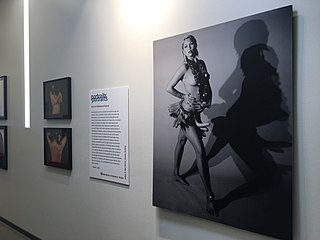
Gallup /nɑ̀ʔnɪ́ʒòːʒɪ́/; Zuni: Kalabwaki) is a city in McKinley County, New Mexico, United States, with a population of 21,605 as of the 2020 census. A substantial percentage of its population is Native American, with residents from the Navajo, Hopi, and Zuni tribes. Gallup is the county seat of McKinley County and the most populous city between Flagstaff and Albuquerque, along the historic U.S. Route 66.

California College of the Arts (CCA) is an art, design, architecture, and writing school with two campuses in California, one in San Francisco and one in Oakland. Founded in 1907, it enrolls approximately 1,225 undergraduates and 400 graduate students.

The Museum of Fine Arts is an art museum in Boston, Massachusetts. It is the 20th-largest art museum in the world, measured by public gallery area. It contains 8,161 paintings and more than 450,000 works of art, making it one of the most comprehensive collections in the Americas. With more than 1.2 million visitors a year, it is the 52nd–most visited art museum in the world as of 2019.

Rudolph Carl Gorman was a Native American artist of the Navajo Nation. Referred to as "the Picasso of American Indian artists" by The New York Times, his paintings are primarily of Native American women and characterized by fluid forms and vibrant colors, though he also worked in sculpture, ceramics, and stone lithography. He was also an avid lover of cuisine, authoring four cookbooks, called Nudes and Food.

Hulleah J. Tsinhnahjinnie is a Seminole-Muscogee-Navajo photographer, museum director, curator, and professor. She is living in Davis, California. She serves as the director of the C.N. Gorman Museum and teaches at University of California, Davis.

The Iris & B. Gerald Cantor Center for Visual Arts at Stanford University, formerly the Stanford University Museum of Art, and commonly known as the Cantor Arts Center, is an art museum on the campus of Stanford University in Stanford, California. The museum first opened in 1894 and consists of over 130,000 sq ft (12,000 m2) of exhibition space, including sculpture gardens. The Cantor Arts Center houses the largest collection of sculptures by Auguste Rodin outside of Paris, with 199 works, most in bronze but others in different media. The museum is open to the public and charges no admission.

Benjamin Alfred Haldane was a Tsimshian professional photographer from Metlakatla, Alaska.

Photography by indigenous peoples of the Americas is an art form that began in the late 19th century and has expanded in the 21st century, including digital photography, underwater photography, and a wide range of alternative processes. Indigenous peoples of the Americas have used photography as a means of expressing their lives and communities from their own perspectives. Native photography stands in contrast to the ubiquitous photography of indigenous peoples by non-natives, which has often been criticized as being staged, exoticized, and romanticized.
Keith F. Davis is an American photography curator, collector, and the author of several books on photography.
Frank Tuttle is a contemporary Native American artist, he is from the Yuki people, Wailaki and Concow Maidu native communities.

Erica Lord is an Alaska Native artist, based in Santa Fe, New Mexico, who identifies herself as a mixed-race "cultural limbo."

Wendy Red Star is a Native American contemporary multimedia artist born in Billings, Montana, in the United States. Her humorous approach and use of Native American images from traditional media draw the viewer into her work, while also confronting romanticized representations. She juxtaposes popular depictions of Native Americans with authentic cultural and gender identities. Her work has been described as "funny, brash, and surreal".
Jean LaMarr is a Northern Paiute/Achomawi artist and activist from California. She creates murals, prints, dioramas, sculptures, and interactive installations. She is an enrolled member of the Susanville Indian Rancheria.

The Manetti Shrem Museum of Art is a fine arts museum located at the University of California, Davis in Davis, California. Its full name is the Jan Shrem and Maria Manetti Shrem Museum of Art.
D.Y. Begay is a Navajo textile artist born into the Tó’tsohnii Clan and born from the Táchii'nii Clan.
Duane Slick is a Meskwaki artist and educator of Ho-Chunk descent. He is known for his monochromatic paintings. He has taught fine arts at Rhode Island School of Design (RISD) since 1995.
George Chester Longfish is a First Nations artist, professor, and museum director. His art work blends Pop art with Indigenous motifs, and often features assemblage. Many of his works have been featured in major public museum exhibitions, including the Heard Museum, and the Smithsonian's National Museum of the American Indian. He was a professor of Native American Studies at the University of California, Davis, for almost 30 years. He served as the museum director at the C.N. Gorman Museum at U.C. Davis, from 1974 to 1996.
Frank Raymond LaPena, also known as Frank LaPeña and by his Wintu name Tauhindauli, was a Nomtipom-Wintu American Indian painter, printmaker, ethnographer, professor, ceremonial dancer, poet, and writer. He taught at California State University, Sacramento, between 1975 to 2002. LaPena helped defined a generation of Native artists in a revival movement to share their experiences, traditions, culture, and ancestry.

Carl Nelson Gorman, also known as Kin-Ya-Onny-Beyeh (1907–1998) was a Navajo code talker, visual artist, painter, illustrator, and professor. He was faculty at the University of California, Davis, from 1950 until 1973. During World War II, Gorman served as a code talker with the United States Marine Corps in the Pacific.











